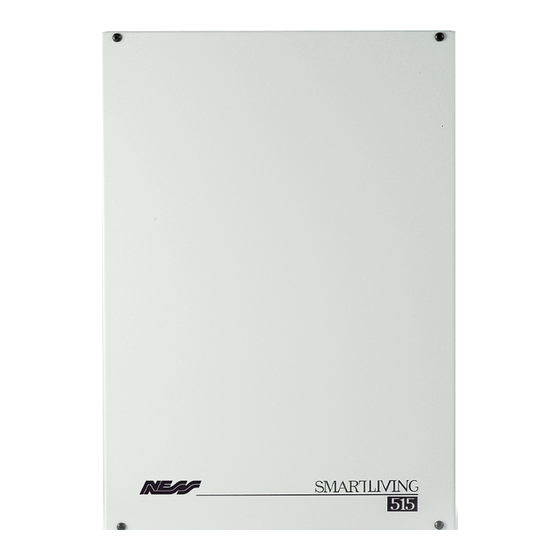Summarization of Contents
ABOUT THIS MANUAL
Terminology 0-1
Defines key terms for the SmartLiving intrusion control system.
Graphic conventions 0-2
Explains symbols and formatting used in the manual for clarity.
GENERAL INFORMATION
Supplier's details 1-1
Provides contact and location information for the manufacturer, Ness Corporation.
Description of the product and various models 1-2
Details the intrusion control panel and its different models.
Products certified and conforming to directives 1-3
Lists certifications and compliance with industry directives for the panel.
Operator Qualifications
Installer 1-6-1
Defines the role and responsibilities of a qualified installer.
User 1-6-2
Describes the roles and access levels of system users.
THE CONTROL PANEL AND PERIPHERALS
Environmental Conditions 2-1
Specifies the operational temperature and humidity for the control panel and peripherals.
SmartLiving intrusion control panels 2-2
Details the SmartLiving series of intrusion control panels.
Peripherals 2-3
Describes various peripheral devices compatible with the control panel.
INSTALLATION
Installing the control panel 3-1
Provides instructions for installing the control panel hardware.
Connecting the backup battery 3-1-4
Explains the procedure for connecting the backup battery to the control panel.
Land-line connection (PSTN) 3-1-7
Explains PSTN connection, Gas Arrestors, and GSM interface options.
Connecting to a PC 3-1-8
Details PC connection via RS232 serial cable or USB adaptor for programming.
Maintenance status 3-1-10
Explains how to enter and use maintenance mode for the control panel and Alien keypad.
Addressing the peripherals 3-3
Explains how to assign unique addresses to peripherals for control panel identification.
Wiring and balancing alarm detectors 3-5
Covers wiring and balancing methods for detectors based on type and desired protection level.
IP and Internet Connectivity 3-11
Explains how to configure network settings for internet connectivity.
INSTALLATION PROJECT VIA THE SMARTLEAGUE
The SmartLeague software programme 5-1
Details the SmartLeague software homepage and its functionalities.
Creating a project layout 5-3
Guides on planning the system layout by selecting and arranging peripherals.
OPTIONS AND PROGRAMMING METHODS
Accessing the Installer menu 6-2
Instructions on how to access the installer menu using a keypad or the system code.
Fast programming from the keypad (Wizard) 6-4
Guides on using the keypad wizard for step-by-step system programming.
Panel options 6-5
Lists and explains various panel options that can be enabled or disabled.
Terminals 6-6
Describes the configuration flexibility of system terminals as inputs, outputs, or other types.
Zones 6-7
Details zone parameters, including description, partition assignment, and zone type.
Outputs 6-8
Details programming of output parameters like description, options, and monostable time.
Telephone 6-10
Covers programming of telephone parameters, including phonebook, protocols, and SMS settings.
Events 6-11
Explains event-generated actions like output activation, notifications, and event memorization.
User Codes 6-14
Covers programming of user codes, PINs, and their assignment to partitions.
Installer codes 6-15
Guides on programming the primary and secondary installer codes.
Keys 6-16
Explains programming parameters for digital keys and wireless keyfobs.
Default settings 6-25
Guides on resetting the control panel to default settings.
User functions 6-26
Describes functions common to installers and users, like viewing logs and status.
Other parameters 6-27
Allows programming of advanced control panel functions.
COMPLIANCY WITH THE REGULATIONS IN FORCE
CEI 79-2
Specifies options that must be programmed for CEI 79-2 compliancy.
EN50131, GRADE 2
Lists options to enable for EN50131 Grade 2 compliance.
ERRORS AND FAULTS
Faults detected by the control panel 8-1
Lists system faults signaled by the keypad yellow LED and their probable causes.
Communication BUS (I-BUS) 8-2
Explains monitoring of the I-BUS and potential communication issues.
LED activity 8-3
Details the function of blue and yellow LEDs on the control panel motherboard for diagnostics.








Need help?
Do you have a question about the SmartLiving 515 and is the answer not in the manual?
Questions and answers